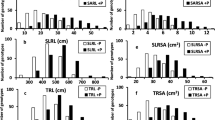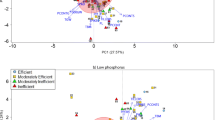Abstract
Three wheat genotypes known to differ in response to high concentrations of boron in the field were grown under controlled glasshouse conditions in soil containing 0, 20 and 60mgkg-1 applied boron. Plant growth was assessed both destructively and non-destructively at regular intervals to identify the responses to high concentrations of boron that best discriminated between the tolerant and the sensitive genotypes, and to determine the optimal growth stage at which to rate the genotypes.
The concentrations of boron in whole shoots, in pots, at the first node and boot stages and in straw at maturity reflected the responses of the three genotypes in the field. Halberd had the lowest tissue boron concentrations, while (W1*MMC)/W1/10 had the highest, but the relative difference in boron concentrations was greater at the early harvests than in the straw at maturity. In contrast to field results, the concentration of boron in grain was not an indicator of the concentration in shoots for the pot experiment.
The ranking of the three genotypes for total dry matter production in pots was the same as ranking for tolerance in the field and was consistent for plants at all growth stages. Likewise, the height of plants four weeks after sowing was an indicator of vigour at the high boron treatment.
The rate of development was reduced at the high boron treatment and development of the sensitive genotype was delayed more than the tolerant genotypes. Tillering was more sensitive to high concentrations of boron than development of the main shoot. The severity of symptoms of boron toxicity increased with increasing boron supply and for successively older leaves and the ranking of genotypes was consistent with that in the field.
It is possible to screen for boron tolerance in the field using both destructive and non-destructive tests on plants grown in pots in the glasshouse, but these tests need to be conducted prior to anthesis as there is better discrimination between genotypes at that time.
Access this chapter
Tax calculation will be finalised at checkout
Purchases are for personal use only
Preview
Unable to display preview. Download preview PDF.
Similar content being viewed by others
References
Aitken R L, Jeffrey A J and Compton B L 1987 Evaluation of selected extractants for boron in some Queensland soils. Aust. J. Soil Res. 25, 363–273.
Cartwright B, Rathjen A J, Sparrow D H B, Pauli J G and Zarcinas B A 1987 Boron tolerance in Australian varieties of wheat and barley. In Genetic Aspects of Plant Mineral Nutrition. Eds. H W Gabelman and B C Loughman. pp 139–151. Kluwer Academic Publishers, Dordrecht, The Netherlands.
Cartwright B, Zarcinas B A and Mayfield A H 1984 Toxic concentrations of boron in a red-brown earth at Gladstone, South Australia. Aust. J. Soil Res. 22, 261–272.
Cartwright B, Zarcinas B A and Spouncer L R 1986 Boron toxicity in South Australian barley crops. Aust. J. Agric. Res. 37, 351–359.
Gupta U C 1971 Boron and molybdenum nutrition of wheat, barley and oats grown in Prince Edward Island soils. Can. J. Soil Sci. 51,415–422.
Khudairi A K 1961 Boron toxicity and plant growth. In Salinity Problems in the Arid Zone. Proceedings of the Tehran Symposium UNESCO Vol. 14, 175–179.
Kluge R and Podlesak W 1985 Plant critical levels for the evaluation of boron toxicity in spring barley (Hordeum vulgare L.). Plant and Soil 83, 381–388.
Moody D B, Rathjen A J, Cartwright B, Pauli J G and Lewis J 1988 Genetic diversity and geographical distribution of tolerance to high levels of soil boron. In Proc. Seventh Int. Wheat Genet. Symp. Eds. T E Miller and R M D Koebner. pp 859–865.
Oertli J J and Kohl H C 1961 Some considerations about the tolerance of various plant species to excessive supplies of boron. Soil Sci. 92, 243–247.
Pauli J G, Cartwright B and Rathjen A J 1988 Responses of wheat and barley genotypes to toxic concentrations of soil boron. Euphytica 39, 137–144.
Rathjen A J, Cartwright B, Pauli J G, Moody D B and Lewis J 1987 Breeding for tolerance of mineral toxicities in Australian cereals with special reference to boron. In Priorities in Soil/Plant Relations for Plant Production. Eds. P G E Searle and B G Davey. pp 111-130. School of Crop Sciences, The University of Sydney.
Soil Survey Staff 1975 Soil Taxonomy. Agric. Handb. No 436, U.S. Dept. Agric, Washington, DC.
Zarcinas B A 1984 Analysis of soil and plant material by inductively coupled plasma-optical emission spectrometry: Comparison of digestion procedures for major and trace constituents in plant material. CSIRO Aust. Div. Soils Divnl. Rept. No. 70.
Zarcinas B A and Cartwright B 1983 Analysis of soil and plant by inductively coupled optical emission spectrometry. CSIRO Aust. Div. Soils Tech. Pap. No. 45.
Author information
Authors and Affiliations
Editor information
Editors and Affiliations
Rights and permissions
Copyright information
© 1990 Kluwer Academic Publishers
About this chapter
Cite this chapter
Paull, J.G., Rathjen, A.J., Cartwright, B., Nable, R.O. (1990). Selection parameters for assessing the tolerance of wheat to high concentrations of boron. In: El Bassam, N., Dambroth, M., Loughman, B.C. (eds) Genetic Aspects of Plant Mineral Nutrition. Developments in Plant and Soil Sciences, vol 42. Springer, Dordrecht. https://doi.org/10.1007/978-94-009-2053-8_54
Download citation
DOI: https://doi.org/10.1007/978-94-009-2053-8_54
Publisher Name: Springer, Dordrecht
Print ISBN: 978-94-010-7421-6
Online ISBN: 978-94-009-2053-8
eBook Packages: Springer Book Archive




